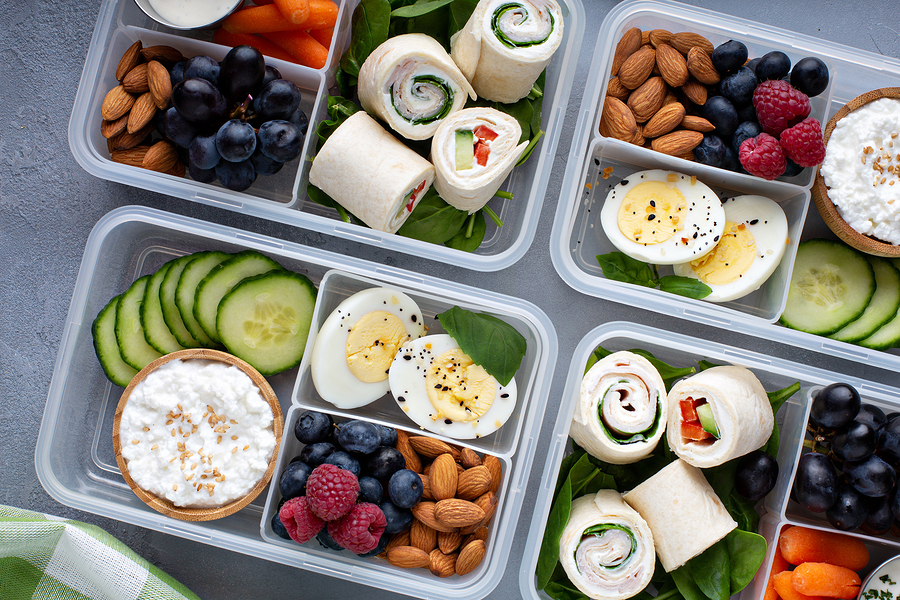It’s easy to get in the habit of eating lunches out or settling for the same old boring lunch from home. It doesn’t have to be that way. Keep your taste buds excited at lunchtime with these simple, healthy, and delicious ideas. Not only will you eat better, but you’ll reap some unexpected rewards.

Download On Track with Barix: Eat Better Meal by Meal – Lunch
The High Cost of Eating Out
The average restaurant meal has 250 more calories than a meal prepared at home. Those extra calories really add up—about 62,500 (or 18 pounds worth) in a year. Calories aren’t the only thing restaurant meals will cost you; the average person who eats most meals out spends an extra $1000 or more a year. What would you do with an extra $1000 right now?
But, I Have No Time
If you add up the time spent getting to and from the restaurant or cafeteria, standing in line to order, and waiting for your food to be prepared; you may realize that you really do have time to make a lunch. Sure, there’s a need to plan, shop, and prepare, but with some simple tips, you’ll make great lunches in no time. Then, instead of running out to lunch, you’ll have time to relax and savor your meal.
But, Brown Bag Lunches are Boring
It’s easy to fall into a ho-hum lunch routine, but it doesn’t have to be that way. A little extra effort and creativity goes a long way. Sometimes making a lunch meal special is as simple as adding an ingredient, sauce or dressing. Keep reading for great ideas on upping your lunch game.
Plan Ahead
A little pre-planning makes life easier. A simple way to start is to make a list of your favorite healthy lunch foods. When planning for other family members, be sure to get their input and ideas. It sounds elementary, but having that list in front of you lets you see just how many options there are. Then, once a week, review your list and decide which foods you’d like to have the following week. If you’re cost conscience, check the grocery store sales flyer first and include dinner left-overs. Finally, put the foods and ingredients on your grocery list and hit the store.
Meal Prep
There is no right way to meal prep and it may be a little different depending on the menu. To keep foods from getting soggy, pack dressings and sauces in separate containers and be sure to purchase microwave-safe containers for reheating.
- Cut up veggies and cook protein, leaving assembly for the night before.
- Assemble an entire week’s worth of meals all at one time.
- Make a large pot of chili, soup or an entree and freeze in individual portion containers.
- Cycle your favorites—chicken salad this week, black bean chili next week, and beef stew the third week. That way you’ll have minimal food prep time.
- Leftovers are a good lunch option. You may want to purposely prepare more for dinner meals so you’ll have extra to pack.
- Utilize healthy pre-packaged foods. Individual packs are convenient and have the added advantage of controlling portions. Just to name a few: tuna, cottage cheese, string cheese, yogurt, fruit cups, crackers, raisins, and soup all come in single-serving packages.
- Another route is to buy foods in bulk and then divide it up into single-serving reusable containers. This takes a bit more time and dishwashing, but is almost always a big money-saver and better for the environment.
Packing Tips
- Pack your lunch the night before to keep your mornings stress-free. Another good option is to take a week’s worth of lunches and stock the work refrigerator.
- Have the right type of containers on hand. The inexpensive semi-disposable type are fine for salads and sandwiches, but you’ll want something microwave safe for hot foods. Newer thermos containers hold soups hot until mealtime. Small dressing, condiment, sauce containers keep foods from getting soggy.
- Get equipped with a lunch bag. Brown paper bags and plastic sandwich bags still work just fine, but there are lots of other options. An insulated lunch bag and a re-freezable ice pack will help your lunch to stay safe and fresh if there isn’t a refrigerator available. Some lunch boxes have handy built-in dividers.
- While you’re at it, be sure to take along calorie-free beverages and healthy high-protein snacks to round out your work day.
Put a little extra effort into your lunches for some extra pizzazz. Here are some ideas to keep your lunch hour fresh and exciting.
Salads
- Top your greens and veggies with hard-cooked eggs, thinly-sliced steak, tuna, shrimp, low-fat cheese, beans, taco meat/fat-free sour cream/avocado/salsa, or chicken for a protein-rich lunch.
- Tomato and cucumber salad–add feta cheese, olive oil and vinegar, and tuna salad. Eat alone or in a wrap.
- Fluff—Gotta love this quick easy lunch or snack treat. Sprinkle sugar-free gelatin powder on fat-free cottage cheese and add a couple tablespoons of sugar-free Cool Whip. Mix together and you have a high-protein treat. Add fruit if desired.
Sandwiches
Interesting sandwiches are a welcome change from the ordinary. Use wraps, low carb tortillas, pita bread, light bread, or lettuce wraps. Add low fat Miracle Whip or mayo, pesto, alfalfa sprouts, avocado, fresh basil, sliced cucumbers, onions, greens, tomatoes or horseradish sauce. Cut your sandwich into small strips to remind yourself to take small bites and chew well.
- California wrap—Mix together chopped ham, shredded low-fat cheese, lettuce, tomato and low-fat Italian dressing. Wrap in a whole-wheat tortilla just prior to serving.
- Chicken salad—Make your favorite low-fat version and eat it by itself or with a few crackers.
- Ham roll-ups—fat-free cream cheese spread on lean deli ham, then rolled up make a delicious lunch. Add green onions if desired.
- Deli rolls—choose your favorite low-fat deli meat (roast beef, chicken, turkey, or ham), add your favorite accompaniments (low-fat cheese, fat-free cream cheese, veggies, and mustard) and roll up in a light wrap, low carb tortilla, or lettuce wrap.
- Grilled chicken Caesar pita–fill a whole wheat pita with mixed greens, grilled chicken and light Caesar dressing.
- PB& J–peanut butter and no-added-sugar jelly on light bread or crackers, or dip banana or apple slices in peanut butter.
Bento Box Lunch
Bento boxes (divided containers) are a great way to pack a portion-controlled lunch with lots of variety. Fill up the containers with a variety of healthy foods like light cheese, lean meat, hard cooked eggs, veggies, fresh fruit, and your lunch is done.
Drinks
- Smoothie—when you don’t have time to chew well, consider a smoothie. Use milk, yogurt, cottage cheese or protein powder as a protein source.
- Ready-to-drink protein drinks are the ultimate in convenience and great to have on hand for those times when nothing on your eating plan is available.
Dairy
- Greek Yogurt is naturally high in protein—add fresh fruit.
- Cottage Cheese is a quick lunch option. Add fresh or canned fruit (packed in water).
- Fairlife milk has 13 grams of protein per cup for a light lunch.
Mexican
- Spread refried beans on a low carb tortilla and heat. Top with lettuce, tomato, salsa, guacamole and shredded cheddar.
- Heat taco meat and top with a small dollop of sour cream and salsa for a satisfying lunch.
- Prep Mexican bowls for the week: start with a base of chicken, salsa, and black or refried beans and divide into microwave safe containers. Portion out shredded lettuce, diced tomato, jalapeno peppers (optional), and a slice of avocado in a separate set of containers.
- Top a salad with black beans, pico de gallo, taco meat, and avocado slices
Hors d’oeuvres
- Hummus—eat it with pita bread, or better yet, fresh veggies.
- Layer lean ham and cheese with cucumber slices and cherry tomatoes.
- Wrap lean deli meat around a piece of string cheese and round out with fresh fruit.
- Shrimp cocktail—buy peeled, cooked and frozen. Thaw out just what you need and add a little cocktail sauce and lemon.
Hot Meals
- Meal prep really comes in handy if you enjoy lunch hot. Make up larger portions, put in microwave safe containers and refrigerate or freeze until time to eat.
- Soups are a great lunch choice as the weather turns cold or the building’s air conditioner is a little too effective. Select broth based soups, chicken or beef chili, or stews. Add in extra protein (think rotisserie chicken) to boost protein.
- Last night’s dinner or that way-too-large restaurant meal is perfect reheated for the next day’s lunch.
Where lunch is concerned, a little extra effort goes a long way to engaging your taste buds and enjoyment.
White Chicken Chili
1-1/2 boneless, skinless chicken breasts
1 large onion, chopped (about 1 cup)
2 cloves garlic, minced
1 can (14 oz) chicken broth
1 tsp. ground cumin
1 tsp. dried oregano leaves
1/2 tsp. salt
1/4 tsp. red pepper sauce
2 cans (15.8 oz size) great northern beans
1 can (15.25 oz size) corn (chickpeas may be substituted)
2 Tbsp. Fresh cilantro, chopped
Place chicken, onion, garlic, broth, cumin, oregano, salt, and red pepper sauce in a large pot. Add water to cover chicken. Cook on medium heat until chicken done. Use a meat thermometer in the largest part of the breast to insure that a safe temperature of 180° is reached. Remove chicken from the pan, shred and return to the pot. Add beans, cilantro and additional water if needed. Cook for an additional 20 minutes and serve. Makes 12 servings.
Nutrition information per serving: 150 calories, 23 grams protein, 3 grams fat, 17 grams
carbohydrate, 466 mg sodium.
South of the Border Lettuce Wraps
3 cups chicken breast, cooked and cubed
1 can (15 oz) black beans, rinsed and drained
1 medium tomato, seeded and finely chopped
½ cup salsa
¼ cup onion, finely chopped
1 can (4 oz) green chilies, chopped
¼ cup sweet red pepper, finely chopped
1 tbsp lime juice
½ teaspoon seasoned salt
¼ teaspoon garlic powder
1 medium ripe avocado, peeled and finely chopped
½ cup reduced fat sour cream
12 Bibb or Boston lettuce leaves
In a large bowl, combine the first 11 ingredients. Refrigerate until serving. Stir in avocado just before serving.
Place ½ cup chicken mixture on each lettuce leaf. Top with 2 teaspoons of sour cream. Fold lettuce over mixture to make a wrap. Makes 12 small wraps.
Nutrition information per serving: 130 calories, 13 grams protein, 4 grams fat, 10 grams carbohydrate, 239 mg sodium.




